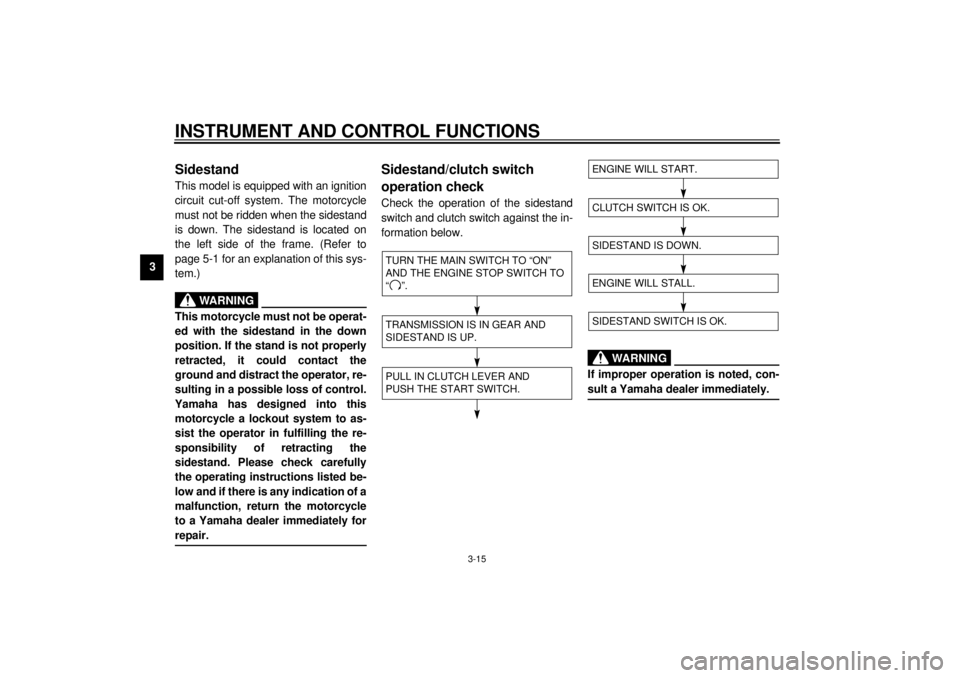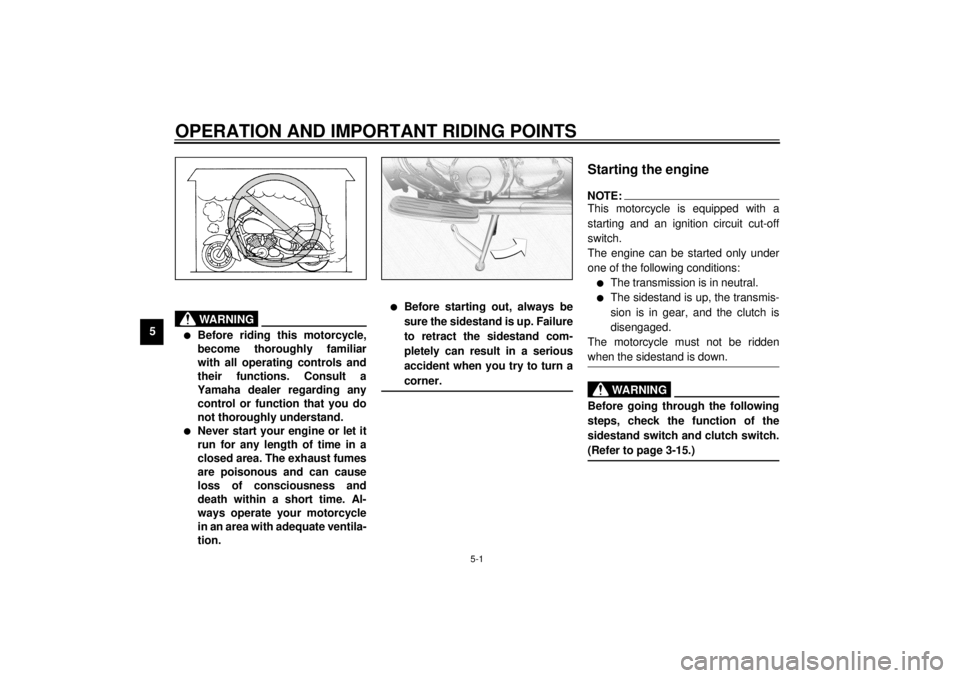2000 YAMAHA XVZ1300A check engine
[x] Cancel search: check enginePage 16 of 91

INSTRUMENT AND CONTROL FUNCTIONS
3-2
3
EAU00057
4. Turn indicator light “ ”
This indicator flashes when the turn
switch is moved to the left or right.
EAU01209
5. Oil level indicator light “ ”
This indicator light will come on if the oil
level is low. To check that the indicator
light is working properly:l
Turn the engine stop switch to “ ”
and the main switch to “ON”.
l
Put the transmission in neutral or
apply the clutch lever.
l
Push the start switch.
If the indicator light does not come on
while pushing the start switch, have a
Yamaha dealer inspect the electrical
circuit.
NOTE:@ Even if the oil is filled to the specified
level, the indicator light may flicker
when riding on a slope or during sud-
den acceleration or deceleration, but
this is normal. @
EAU01257
6. Engine overheat indicator light
“”
This indicator light will come on if the
engine overheats. If the light comes on,
stop the engine immediately and allow
the engine to cool. To check that the in-
dicator light is working properly:l
Turn the engine stop switch to “ ”
and the main switch to “ON”.
l
Put the transmission in neutral or
apply the clutch lever.
l
Push the start switch.
If the indicator light does not come on
while pushing the start switch, have a
Yamaha dealer inspect the electrical
circuit.
EAU01272
7. Overdrive / Engine trouble indica-
tor light “O/D / ”l
This indicator light will come on
when the transmission is in over-
drive (5th gear).
l
This indicator light will also come
on or flash if trouble occurs in an
engine monitoring circuit. In such
a case, take the motorcycle to a
Yamaha dealer to have the self-di-
agnostic systems checked.
E_4YP_Functions.fm Page 2 Wednesday, October 6, 1999 10:03 AM
Page 23 of 91

INSTRUMENT AND CONTROL FUNCTIONS
3-9
3
RES
This indicates reserve. If you run out of
fuel while riding, set the fuel cock to this
position. Fill the tank at the first oppor-
tunity. Be sure to set the fuel cock back
to “ON” after refueling!
EAU03032
Starter (choke) knobStarting a cold engine requires a richer
air-fuel mixture, which is supplied by
the starter (choke).
Move the knob in direction
a to turn on
the starter (choke).
Move the knob in direction
b to turn off
the starter (choke).
EAU01214
Steering lockThe steering lock is located on the left
side of the head pipe.
To lock the steering
1. Turn the handlebars all the way to
the right.
2. Open the steering lock cover.
3. Insert the key and turn it counter-
clockwise 1/8 turn.
4. Push the key in and turn it back
1/8 turn clockwise.
5. Check that the steering is locked.
6. Remove the key and close the
steering lock cover.
1. Pointed end positioned over “RES”RES: reserve position
1. Steering lock
E_4YP_Functions.fm Page 9 Wednesday, October 6, 1999 10:03 AM
Page 29 of 91

INSTRUMENT AND CONTROL FUNCTIONS
3-15
3
EAU00330
SidestandThis model is equipped with an ignition
circuit cut-off system. The motorcycle
must not be ridden when the sidestand
is down. The sidestand is located on
the left side of the frame. (Refer to
page 5-1 for an explanation of this sys-
tem.)
EW000044
WARNING
@ This motorcycle must not be operat-
ed with the sidestand in the down
position. If the stand is not properly
retracted, it could contact the
ground and distract the operator, re-
sulting in a possible loss of control.
Yamaha has designed into this
motorcycle a lockout system to as-
sist the operator in fulfilling the re-
sponsibility of retracting the
sidestand. Please check carefully
the operating instructions listed be-
low and if there is any indication of a
malfunction, return the motorcycle
to a Yamaha dealer immediately for
repair. @
EAU00331
Sidestand/clutch switch
operation checkCheck the operation of the sidestand
switch and clutch switch against the in-
formation below.CD-11E
CD-11E
EW000045
WARNING
@ If improper operation is noted, con-
sult a Yamaha dealer immediately. @
TURN THE MAIN SWITCH TO “ON”
AND THE ENGINE STOP SWITCH TO
“”.TRANSMISSION IS IN GEAR AND
SIDESTAND IS UP.PULL IN CLUTCH LEVER AND
PUSH THE START SWITCH.
ENGINE WILL START.SIDESTAND IS DOWN.ENGINE WILL STALL.SIDESTAND SWITCH IS OK.CLUTCH SWITCH IS OK.
E_4YP_Functions.fm Page 15 Wednesday, October 6, 1999 10:03 AM
Page 31 of 91

4-1
4
EAU01114
4-PRE-OPERATION CHECKSOwners are personally responsible for their vehicle’s condition. Your motorcycle’s vital functions can start to deteriorate
quickly and unexpectedly, even if it remains unused (for instance, if it is exposed to the elements). Any damage, fluid leak or
loss of tire pressure could have serious consequences. Therefore, it is very important that, in addition to a thorough visual in-
spection, you check the following points before each ride.
EAU00340
PRE-OPERATION CHECK LIST
ITEM CHECKS PAGE
Front brake• Check operation, fluid level and vehicle for fluid leakage.
• Fill with DOT 4 brake fluid if necessary.
6-17 ~ 6-21
Rear brake• Check operation, fluid level and vehicle for fluid leakage.
• Fill with DOT 4 brake fluid if necessary.
Clutch• Check operation, fluid level and vehicle for fluid leakage.
• Fill with DOT 4 brake fluid if necessary.6-16
Throttle grip and housing• Check for smooth operation.
• Lubricate if necessary.6-12
Engine oil• Check oil level.
• Fill with oil if necessary.6-7 ~ 6-9
Coolant reservoir tank• Check coolant level.
• Fill with coolant if necessary.6-10 ~ 6-11
Final gear oil• Check vehicle for leakage. 6-10
Wheels and tires• Check tire pressure, wear and for damage. 6-13 ~ 6-16
Brake and shift pedal
shafts• Check for smooth operation.
• Lubricate if necessary.6-21
Brake and clutch lever
pivots• Check for smooth operation.
• Lubricate if necessary.6-22
Sidestand pivot• Check for smooth operation.
• Lubricate if necessary.6-22
E_4YP_Preop.fm Page 1 Wednesday, October 6, 1999 10:04 AM
Page 35 of 91

5-1
5
EAU00372
5-OPERATION AND IMPORTANT RIDING POINTS
EAU00373
WARNING
@ l
Before riding this motorcycle,
become thoroughly familiar
with all operating controls and
their functions. Consult a
Yamaha dealer regarding any
control or function that you do
not thoroughly understand.
l
Never start your engine or let it
run for any length of time in a
closed area. The exhaust fumes
are poisonous and can cause
loss of consciousness and
death within a short time. Al-
ways operate your motorcycle
in an area with adequate ventila-
tion.
l
Before starting out, always be
sure the sidestand is up. Failure
to retract the sidestand com-
pletely can result in a serious
accident when you try to turn a
corner.
@
EAU01588
Starting the engineNOTE:@ This motorcycle is equipped with a
starting and an ignition circuit cut-off
switch.
The engine can be started only under
one of the following conditions:l
The transmission is in neutral.
l
The sidestand is up, the transmis-
sion is in gear, and the clutch is
disengaged.
The motorcycle must not be ridden
when the sidestand is down.
@
EW000054
WARNING
@ Before going through the following
steps, check the function of the
sidestand switch and clutch switch.
(Refer to page 3-15.) @
E_4YP_Operation.fm Page 1 Wednesday, October 6, 1999 10:05 AM
Page 36 of 91

OPERATION AND IMPORTANT RIDING POINTS
5-2
5 1. Turn the fuel cock to “ON”.
2. Turn the main switch to “ON” and
the engine stop switch to “ ”.
EC000037
CAUTION:@ If the fuel level indicator light comes
on, check the fuel level. If neces-
sary, add fuel. @3. Shift transmission into neutral.NOTE:@ When the transmission is in neutral, the
neutral indicator light should be on. If
the light does not come on, ask a
Yamaha dealer to inspect it. @
4. Turn on the starter (choke) and
completely close the throttle grip.
5. Start the engine by pushing the
starter switch.NOTE:@ If the engine fails to start, release the
starter switch, wait a few seconds, then
try again. Each attempt should be as
short as possible to preserve the bat-
tery. Do not crank the engine more
than 10 seconds on any one attempt. @
ECA00003
CAUTION:@ The oil level indicator light and en-
gine overheat indicator light should
come on when the start switch is
pushed and should go off when the
start switch is released. If the oil lev-
el indicator light flickers or remains
on, immediately stop the engine and
check the engine oil level and for oil
leakage. If necessary, fill the engine
with oil and check to see that the oil
level indicator light goes off. If not,
consult a Yamaha dealer. @
E_4YP_Operation.fm Page 2 Wednesday, October 6, 1999 10:05 AM
Page 42 of 91

6
PERIODIC MAINTENANCE AND MINOR REPAIR
Tool kit................................................................... 6-1
Periodic maintenance and lubrication ................... 6-3
Spark plugs........................................................... 6-6
Engine oil .............................................................. 6-7
Final gear oil ....................................................... 6-10
Coolant ............................................................... 6-10
Carburetor adjustment ........................................ 6-11
Idle speed adjustment ........................................ 6-11
Throttle cable free play inspection ...................... 6-12
Valve clearance adjustment ................................ 6-12
Tires .................................................................... 6-13
Wheels ................................................................ 6-15
Clutch lever free play adjustment........................ 6-16
Front brake lever free play adjustment ................ 6-17
Rear brake pedal height adjustment ................... 6-17Brake light switch adjustment ............................. 6-18
Checking the front and rear brake pads ............. 6-19
Inspecting the brake fluid level ........................... 6-19
Brake fluid replacement ..................................... 6-21
Brake and shift pedal lubrication ........................ 6-21
Brake and clutch lever lubrication ...................... 6-22
Sidestand lubrication.......................................... 6-22
Front fork inspection ........................................... 6-23
Battery................................................................ 6-23
Fuse replacement .............................................. 6-25
Headlight bulb replacement ............................... 6-27
Turn signal and taillight bulb replacement .......... 6-28
Troubleshooting .................................................. 6-28
Troubleshooting chart ......................................... 6-29
E_4YP_PeriodicTOC.fm Page 1 Wednesday, October 6, 1999 10:05 AM
Page 47 of 91

PERIODIC MAINTENANCE AND MINOR REPAIR
6-5
6
EAU02971
NOTE:@ l
The air filter needs more frequent service if you are riding in unusually wet or dusty areas.
l
Hydraulic brake and clutch systems
• After disassembling the master cylinder, caliper or clutch release cylinder, always replace the brake fluid. Check the
brake fluid level of the master cylinder and clutch release cylinder regularly and fill as required.
• Replace the oil seals on the inner parts of the master cylinder, caliper and clutch release cylinder every two years.
• Replace the brake and clutch hoses every four years or if cracked or damaged.
@20
*Carburetors• Check engine idling speed, synchronization and starter operation.
• Adjust if necessary.ÖÖÖ
21 Engine oil• Check oil level and vehicle for oil leakage.
• Correct if necessary.
• Change. (Warm engine before draining.)ÖÖÖ
22 Engine oil filter cartridge•Replace.ÖÖ
23*Cooling system• Check coolant level and vehicle for coolant leakage.
• Correct if necessary.
• Change coolant every 24,000 km or 24 months (whichever comes
first).ÖÖ
24 Final gear oil• Check oil level and vehicle for oil leakage.
• Change oil at initial 1,000 km and thereafter every 24,000 km
or 24 months (whichever comes first).ÖÖÖ NO. ITEM CHECKS AND MAINTENANCE JOBSINITIAL
(1,000 km)EVERY
6,000 km
or
6 months
(whichever
comes first)12,000 km
or
12 months
(whichever
comes first)
* Since these items require special tools, data and technical skills, they should be serviced by a Yamaha dealer.
E_4YP_Periodic.fm Page 5 Wednesday, October 6, 1999 10:05 AM